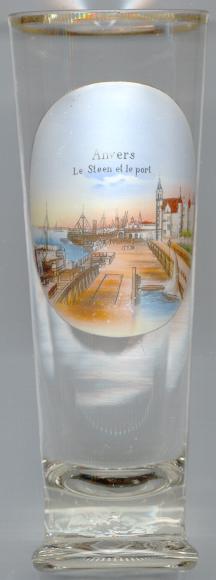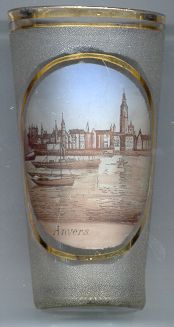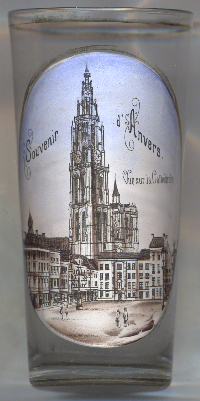

|
| BELGIË / BELGIQUE / BELGIEN | BELGIUM |
| gewest/région/Region: Vlaanderen / Flandre / Flandern | region: Flanders |
| provincie/province/Provinz: Antwerpen / Anvers / Antwerpen | province: Antwerp |
de, nl: Antwerpen
| fr: Anvers
| |
 Antwerpen is situated on the river Schelde (French: Escaut; English: Scheldt) in Northern Belgium. It is the capital of the Antwerpen province and is one of the busiest ports in Europe.
The city is also a major international centre of diamond industry and the seat of the World's oldest stock exchange (founded in 1460).
Antwerpen is situated on the river Schelde (French: Escaut; English: Scheldt) in Northern Belgium. It is the capital of the Antwerpen province and is one of the busiest ports in Europe.
The city is also a major international centre of diamond industry and the seat of the World's oldest stock exchange (founded in 1460).
Excavations have shown that the area was habitated already in the Gallo-Roman period (2nd or 3rd century AD).
Like many Flemish cities Antwerpen grew up around two settlements: the aanwerp (alluvial mound) from witch the city probably derives its name,
and Caloes, about 500 meters further south. A fortification was built on the mound around the 7th century. Christianization also began in that period.
In the 9th century, when Antwerpen became part of Lorraine, that ‘castellum’ was destroyed by the Normans. The present-day castle,
the  Steen, still comprises parts of a castle built in his place in the 10th century.
At the end of the 10th century Antwerpen became a margraviate of the Holy Roman Empire. The border was the river Schelde.
In the 12th century Antwerpen was part of the Duchy of Brabant. In the first half of the 14th century Antwerpen became the most important trading and financial centre in
Western Europe; its reputation was based largely on its seaport and wool market. In 1356 the city was annexed to the county of Flanders and lost many of its privileges.
However, in the 15th/16th century Antwerpen again became a centre of trade and culture and was even described as „the loveliest city in the world“.
Steen, still comprises parts of a castle built in his place in the 10th century.
At the end of the 10th century Antwerpen became a margraviate of the Holy Roman Empire. The border was the river Schelde.
In the 12th century Antwerpen was part of the Duchy of Brabant. In the first half of the 14th century Antwerpen became the most important trading and financial centre in
Western Europe; its reputation was based largely on its seaport and wool market. In 1356 the city was annexed to the county of Flanders and lost many of its privileges.
However, in the 15th/16th century Antwerpen again became a centre of trade and culture and was even described as „the loveliest city in the world“.
 In the second half of the 16th century, the struggle between the Protestant North and Catholic Spain led to disastrous events for the city: the iconoclasm in 1566,
the Spanish Fury in 1576, and finally the fall of Antwerpen in 1585. Antwerpen came under the rule of Philip II of Spain, the Northern Netherlands closed off the river.
By 1590 only about 40,000 of the about 100,000 inhabitants in 1570 remained. Yet until the mid-17th century the town continued to flourish culturally.
As the river remained closed, the town lost most of its importance and the once striving metropolis finally was reduced to a mere provincial town.
Under Austrian rule (1715–1792), Emperor Joseph II unsuccessfully tried to free the river by military force. In 1795, under French rule (1792–1815),
Napoleon Bonaparte succeeded in freeing the river in 1795 but encountered a blockade by England.
After Napoleon's fall at Waterloo in 1815, Antwerpen was reunited with the Northern Netherlands, but the ensuing period of prosperity ended with the Belgian Revolution in 1830.
Once again, the river was closed and remained so until 1863. Apart from interruptions during the two world wars, Antwerpen has experienced steady economic growth in the 20th century.
Antwerpen was selected by the Council of the European Union to be European City of Culture for 1993.
The belfries of the Cathedral of Our Lady and of the Antwerp City Hall are two of the 56 of its kind in Belgium and France that were designated by
UNESCO as World heritage sites in 1999; the Plantin-Moretus Museum was added to this list in 2005, Le Corbusier's
Maison Guiette was added in 2016.
In the second half of the 16th century, the struggle between the Protestant North and Catholic Spain led to disastrous events for the city: the iconoclasm in 1566,
the Spanish Fury in 1576, and finally the fall of Antwerpen in 1585. Antwerpen came under the rule of Philip II of Spain, the Northern Netherlands closed off the river.
By 1590 only about 40,000 of the about 100,000 inhabitants in 1570 remained. Yet until the mid-17th century the town continued to flourish culturally.
As the river remained closed, the town lost most of its importance and the once striving metropolis finally was reduced to a mere provincial town.
Under Austrian rule (1715–1792), Emperor Joseph II unsuccessfully tried to free the river by military force. In 1795, under French rule (1792–1815),
Napoleon Bonaparte succeeded in freeing the river in 1795 but encountered a blockade by England.
After Napoleon's fall at Waterloo in 1815, Antwerpen was reunited with the Northern Netherlands, but the ensuing period of prosperity ended with the Belgian Revolution in 1830.
Once again, the river was closed and remained so until 1863. Apart from interruptions during the two world wars, Antwerpen has experienced steady economic growth in the 20th century.
Antwerpen was selected by the Council of the European Union to be European City of Culture for 1993.
The belfries of the Cathedral of Our Lady and of the Antwerp City Hall are two of the 56 of its kind in Belgium and France that were designated by
UNESCO as World heritage sites in 1999; the Plantin-Moretus Museum was added to this list in 2005, Le Corbusier's
Maison Guiette was added in 2016.
The artistic fame of Antwerp dates from the rule of Philip the Good, Duke of Burgundy (1396–1467; duke 1419), who founded an academy of painting. The painters Quentin Massys (1466–1530) and Peter Paul Rubens (1577–1640) resided in the city, and Antoon Van Dyck (1599–1641) was born here. Many of their works are in the museums and churches of Antwerpen. The book-binder and publisher Christophe Plantin (1514–1589) made the city a center of printing; his house is a museum.

The Roman Catholic  Cathedral of Our Lady (Onze-Lieve-Vrouwekathedraal) [left, no. 4888]
is the largest Gothic church in Belgium, with its tower rising 123 metres over the city. The belfry of the cathedral is included
in the Belfries of Belgium and France entry in the list of UNESCO World Heritage Sites. The first church,
dedicated to Saints Peter and Paul, was founded in the 7th century. Damaged and restored in the 9th century and subsequently
dedicated to Saint Michael it became the parish church of Antwerp. Becoming more popular, the chapel was demolished and replaced by a
much bigger Romanesque church. In 1294, the church got a novum opus extension, indicating the first signs of Gothic architecture.
In 1352, construction was begun on a new Our Lady's church which would become the largest Gothic church in Belgium. During the night
of 5–6 October 1533, the new church caught fire. The church was made the cathedral of the bishopric of Antwerp in 1559.
During the Iconoclasm of 1566, Protestants destroyed a large part of the cathedral's interior. When Antwerp came under Protestant
administration in 1581 a number of artistic treasures were once again destroyed, removed or sold. With the fall of Antwerp in 1585
Roman Catholic authority was restored. In 1794 the French revolutionaries who conquered the region plundered Our Lady's Cathedral and
inflicted serious damage. The church lost its status as cathedral in 1801 during the period of French occupation of Belgium by the
promolgation of the Concordat of 1801. Over the course of the 19th century, the church was completely restored and refurnished.
The Cathedral was looted and vandalized in 1914 by German soldiers after the Siege of Antwerp in 1914. Many of its treasures were
taken to Berlin and not returned until after the Armistice of 11 November 1918. church regained the status of a cathedral again in
1961. A complete restoration took place between 1965 and 1993.
[https://en.wikipedia.org/wiki/Cathedral_of_Our_Lady_(Antwerp)]
Cathedral of Our Lady (Onze-Lieve-Vrouwekathedraal) [left, no. 4888]
is the largest Gothic church in Belgium, with its tower rising 123 metres over the city. The belfry of the cathedral is included
in the Belfries of Belgium and France entry in the list of UNESCO World Heritage Sites. The first church,
dedicated to Saints Peter and Paul, was founded in the 7th century. Damaged and restored in the 9th century and subsequently
dedicated to Saint Michael it became the parish church of Antwerp. Becoming more popular, the chapel was demolished and replaced by a
much bigger Romanesque church. In 1294, the church got a novum opus extension, indicating the first signs of Gothic architecture.
In 1352, construction was begun on a new Our Lady's church which would become the largest Gothic church in Belgium. During the night
of 5–6 October 1533, the new church caught fire. The church was made the cathedral of the bishopric of Antwerp in 1559.
During the Iconoclasm of 1566, Protestants destroyed a large part of the cathedral's interior. When Antwerp came under Protestant
administration in 1581 a number of artistic treasures were once again destroyed, removed or sold. With the fall of Antwerp in 1585
Roman Catholic authority was restored. In 1794 the French revolutionaries who conquered the region plundered Our Lady's Cathedral and
inflicted serious damage. The church lost its status as cathedral in 1801 during the period of French occupation of Belgium by the
promolgation of the Concordat of 1801. Over the course of the 19th century, the church was completely restored and refurnished.
The Cathedral was looted and vandalized in 1914 by German soldiers after the Siege of Antwerp in 1914. Many of its treasures were
taken to Berlin and not returned until after the Armistice of 11 November 1918. church regained the status of a cathedral again in
1961. A complete restoration took place between 1965 and 1993.
[https://en.wikipedia.org/wiki/Cathedral_of_Our_Lady_(Antwerp)]
![[scale]](lineal.jpg)